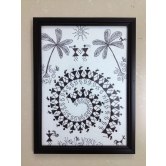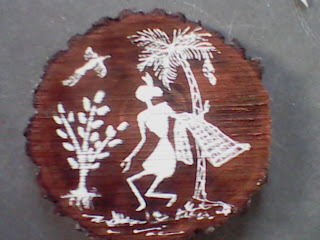Warli Painting History & Information
Wednesday, 23 January 2013
Warli Handicrafts Product
I
am sharing with you the Warli Art pieces with you in this post. The
artists were from the Warli district, in the foothills of Western Ghats
of Maharashtra, India. The tribal people of this place are in
international limelight today for this art. Studies in this field
indicate that this form of art started some time in 10th century AD.
Warli Painting History
 |
| Life Of warli Tribes |
Warli Painting History :
While there are no records of the exact origins of this art, its roots may be traced to as early as the 10th century AD. Research suggests that the tribal are the propagators of a tradition which originated sometime in the Neolithic period between 2,500 BC and 3,000 BC.
Warli paintings were mainly done by the women folk. The most important aspect of the painting is that it does not depicts mythological characters or images of deities, but depict social life. Pictures of human beings and animals, along with scenes from daily life are created in a loose rhythmic pattern.
Warli paintings are painted white on mud walls. The paintings are beautifully executed and resembles pre-historic cave paintings in execution and usually depict scenes of human figures engaged in activities like hunting, dancing, sowing and harvesting
Warli Paintings are very
different from other folk and tribal paintings in India. Their themes are not
mythological, nor their colours as bright as the ones seen in Madhubani
Paintings. Neither do they contain the robust sensuality of the paintings found
in Eastern India.
Instead they are painted on mud, charcoal, cow
dung based surface using Natural Dyes in white with series of dots in red and
yellow.
Their linear nature and monochromatic hues make them similar to pre-historic cave paintings and Aboriginal Art in execution.
Their linear nature and monochromatic hues make them similar to pre-historic cave paintings and Aboriginal Art in execution.
Warli Paintings usually
depict scenes of human figures engaged in activities like hunting, dancing,
sowing and harvesting. These paintings also serve social and religious
aspirations of the local people, since it is believed that these
paintings invoke powers of the Gods.
Value of warli art
The Tribal values the sense of uniformity and the close social interactions with nature and the spirits is what makes the Tribal who they are. For the tribals, life is an eternal circle. Death is not the end as much as it is a new beginning. Hence circles best represent the art of Tribal, which has neither an end nor a beginning.
The purpose of these drawings remain ritual as it did from ancient times, that of projecting and invoking power, virility, protection from unknown diseases, and the dark supernatural forces which have to be kept appeased and satisfied at all times. The paintings pulsate with energy and are a vehicle for the tribal innermost urges
Content of warli art
Their extremely
rudimentary wall paintings use a very basic graphic vocabulary:
a circle,
a triangle and
a square.
The circle drawn from
nature represents the sun and the moon
while the triangle is
derived from mountains and pointed trees. The square indicates a sacred
enclosure,
the square, the “chauk” ;
for the Palaghata, the mother goddess, symbolising fertility.
Scenes portraying hunting, fishing and
farming, festivals and dances, trees and animals surround the central motif in
these ritual paintings.
Human and animal bodies
are represented by two triangles joined at the tip, the upper triangle
depicting the trunk and the lower triangle the pelvis. Their precarious
equilibrium symbolises the balance of the universe, and of the couple, and has
the practical and amusing advantage of animating the bodies.
Trees, birds, men and
women collaborate to create a composite whole in Tribal Paintings. Warli
Painting and the paintings of the tribe of Maharashtra are the most joyous
celebration of that very philosophy. Even spiral formations of men and women
and concentric circular designs in Warli Paintings are symbolic of the circle
of life. In fact most of these seemingly simple paintings abound in symbolism.
The harmony and balance depicted in these paintings is supposed to signify the
harmony and balance of the universe. Unlike other tribal art forms the Warli
Paintings do not employ religious iconography, making it a more secular art
form.
Marriage is the most recurring theme of Warli paintings. Many Warli paintings depict Warli Paintings - Marriage Theme Palghat, the marriage god, accompanied by a horse and of course the bride and the groom.
Marriage is the most recurring theme of Warli paintings. Many Warli paintings depict Warli Paintings - Marriage Theme Palghat, the marriage god, accompanied by a horse and of course the bride and the groom.
They consider these
paintings sacred. Men and women dancing in circles (Tarapa Dance), during
various celebrations, is another theme typical to the Warli Paintings. A
musician playing a native instrument is usually found in the middle of such
spirals (Tarapa). Flora and fauna are also depicted in these paintings. The
cracked walls of the village have been adorned with these paintings for
centuries and even today they form the primary decoration of most such houses
what warli painting says?
The sacred nature of the
trees is suggested by their soaring heights in relation to the men and beasts.
Dances of spring, of budding trees, of the meeting of lovers, and the poise and
abandon form an important repertoire in tribal vocabulary. Nothing is static;
the trees, the human figures, the birds challenge and respond to each other,
create tensions and resolve them. The art of the Tribal people symbolises man's
harmony with each other and with nature. These paintings also supposedly invoke
powers of the Gods.
The original symbolism of the paintings was (and still is) found in marriage ceremonies, which could not take place until a painting was complete. tribal call them as “Lagnacha chauk” meaning marriage paintings.
The original symbolism of the paintings was (and still is) found in marriage ceremonies, which could not take place until a painting was complete. tribal call them as “Lagnacha chauk” meaning marriage paintings.
Typical
Warli Paintings Material
Typically Warlis are simply painted on mud, charcoal and cow dung treated surfaces with rice paste for the colour white.
But now
people have adapted in modern form which consists of permanent colours .So you
can also make one as it is a very simple art form of painting. You Don’t need
any specialized knowledge but just a creative mind and artistic flair..
Materials Required
• Cloth/Handmade paper
• Trace paper
• Metallic colours(for cloth)
• Poster colours (for paper)
• White poster
• Carbon sheet
So let’s start
Step 1:
Choose a design
Step 2:
First draw the required pattern on the trace paper and copy the design into the cloth/paper using carbon sheet.
Step3:
If using Cloth Paint using metallic colours and let it dry well.
Use Poster colours for paper
Step4:
Draw outlines using the white colour and again leave it to dry for 24 hours.
If applying on cloth iron on the back side of the cloth.
Tips and tricks
•Experiment with materials. You
can get this work done on your bed sheets, saris, dresses, cushion covers and
curtains also.
•Don’t restrain yourself on paper or cloth . Try making a stylish pot ,napkin holder ,lampshades or just give a try …make a bookmark
•First draw the circle and then draw then join them to form a coil with freehand.
•If applying on wall ,then use apex as base paint
•Combine figures with beautiful patterns like peacock, well, trees etc.
•If you have a traditional look of your house. These Warlis would look great on wall. A simple corner with pots, chicks and Warli on wall will add new dimensions to your house.
•Add mirrors or colourful threads , if you want that extra shine in your painting .
•Add a border to make it look more attractive
•If using “geru”as your base ,mix it with linseed oil (or similar media) so that it stays longer
Hope these would help you. Do share your views and ideas and post your comments. Go through the links on the right for collection of Warli art designs.
•Don’t restrain yourself on paper or cloth . Try making a stylish pot ,napkin holder ,lampshades or just give a try …make a bookmark
•First draw the circle and then draw then join them to form a coil with freehand.
•If applying on wall ,then use apex as base paint
•Combine figures with beautiful patterns like peacock, well, trees etc.
•If you have a traditional look of your house. These Warlis would look great on wall. A simple corner with pots, chicks and Warli on wall will add new dimensions to your house.
•Add mirrors or colourful threads , if you want that extra shine in your painting .
•Add a border to make it look more attractive
•If using “geru”as your base ,mix it with linseed oil (or similar media) so that it stays longer
Hope these would help you. Do share your views and ideas and post your comments. Go through the links on the right for collection of Warli art designs.
If you have want to know about other beautiful form of Indian painting click the Below attachment.
-
Cultural Epitome Handicrafts Co.
Specialty :
 |
| Warli Design Product |
Handicrafts
T-shirts
Interior Design Product
Hand-made Office Stationary
Decorative product
Lifestyle Product
Warli Paintings Frames
Contact Details :
Shreekant Lachake
Director
Cultural Epitome Handicrafts Export Co.
Phone : 9270880224/9604099904
Email : culturalepitome@india.com
Address :208. Sarda Sankul, Mahatma Gandhi Road
Mashik-422001
Social Network
in.linkedin.com/pub/cultural-epitome/57/673/116/
http://www.facebook.com/CulturalEpitomeHandicraftsExportCo
Subscribe to:
Comments (Atom)




























